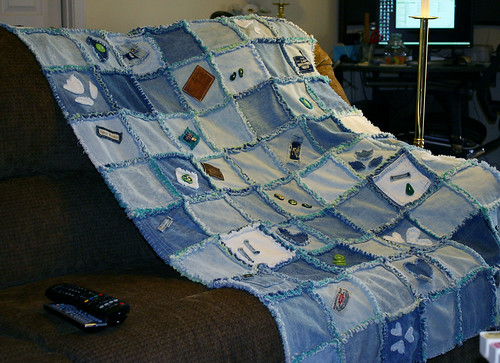I finally completed the ragging process on my lap quilt, this afternoon. Here's the detailed play-by-play, in case anyone's interested (and in case I should forget my own process, if it takes me another couple of years to get the next rag quilt ready for ragging):
First, I made a "blanket bag" for washing the quilt in, to catch the lint and loose threads that might otherwise clog the drain. I took an old queen size flat sheet, folded it in half, and pinned the two halves together. I sewed together two of the open sides, leaving one of the two shorter sides unsewn. I then removed the pins and turned the whole thing so that the seam was hidden inside. (That might not have been necessary, but it's a force of habit.)
I decided to try out one of the tips I recently wrote about-- that of throwing the quilt into the dryer on "air" (without heat) for a few minutes prior to washing. It did take out a fair bit of lint and loose threads, but I don't know that it was really worth the effort.
Next step-- I put the quilt into my "washing bag". (There was plenty of room, so I should be able to use the bag for larger quilts, if I get ambitious.) I then folded down the open side of the bag. I folded it a couple of times and pinned it shut with a handful of safety pins. Twisting the sheet/bag further down (between the safety pins and the area at the bottom with the quilt in it), I closed it a second time with a sturdy rubber band. This method seems to have kept the loose fluff inside the bag. At least, I didn't see any escaping threads.
I put in the detergent and fabric softener and set the machine for an extra-long wash. (I'm not sure what the best combination of settings would be for optimal ragging, but I figured that the longer the quilt is agitated, the more opportunity it has to fray.) I checked it a couple of times during washing, just to make sure the bag hadn't come open. When the washer finished, I took off the pins and rubber band, but I left the bag unopened.
I took the bag out to an out-of-the-way part of the yard (thanks to my experience with smaller rag quilting projects), then emptied the bag and shook the quilt and bag separately. (These denim quilts are quite heavy when wet. The main thing is to get off the larger clumps of lint and thread.) There was a lot of wet fluff, which I removed as well as I could.
I took both quilt and bag inside and put them directly into the clothes dryer. I set it and let it go about its business (careful to make sure the lint filter was clean, beforehand). I then checked the lint filter every ten minutes, for the first thirty minutes or so. There was a great deal of lint and thread the first couple of times. (You'd be amazed how much lint and "stuff" these things generate!) After that, it decreased, but I still took care to check it every so often and clean it, just in case. (Keeping your lint filter clean prevents fires, and it also increases the efficiency of the machine.)
I took it out of the dryer at one point and gave it a look-over. I quickly noticed one seam I'd neglected to snip! (And this was after I thought I'd carefully examined the quilt for that very thing. Just goes to show how easy it is to miss!) I quickly snipped that seam and put it back in the dryer. Though there is some difference in the degree of ragging in that one seam and the rest of the seams, it's not terribly noticeable-- especially if you don't know where to look for it.
When the quilt was dry, there were a few spots that could use a little trimming, and some of it was still a bit linty. A little time with scissors and a lint brush soon took care of that-- and then it was done! (Well, except for one tiny spot where two squares are coming apart. I need to take a needle and thread and fix that before it catches on something and make a bigger hole. But for the most part, it's done!)
There are a couple more photos over on my Flickr photostream, if you're interested. :o)

